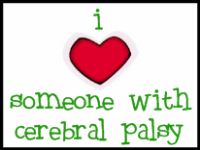Three years ago I was not aware of all of the In's and outs of what cerebral palsy was I would have been way off. I knew of the "stereo typical" child with cerebral palsy. I didn't know that that word would become something that I have become more familiar with as each day passes.
While in the NI CU learning how to care for my son we were told many times that he "could be " in a wheelchair. He "could" be just fine. He could be this and he could be that.
I knew he was on the "high end of normal" muscle tone from the beginning and we had a wonderful doctor who watched and didn't feel it needed to go much further. Ty was hitting milestones. He was hitting them late but they were being met.
Around age 2 is when that word Cerebral Palsy came into our everyday existence. And it was also the time that it didn't change anything but yet changed everything all at the same time.
Ty was diagnosed with Cerebral palsy but I don't remember when. Why? Because everyone that we talked to about it seemed to blow off my questions and my direct questions of do we or do we not have it.
What is it?
"Cerebral" refers to the brain and "Palsy" to a disorder of movement or posture. If someone has cerebral palsy it means that because of an injury to their brain (cerebral) they are not able to use some of the muscles in their body in the normal way (palsy). Children with cerebral palsy may not be able to walk, talk, eat or play in the same ways as most other children.
Cerebral palsy is neither progressive nor communicable. It is also not "curable" in the accepted sense, although education, therapy and applied technology can help persons with cerebral palsy lead productive lives. It is important to know that cerebral palsy is not a disease or illness. It isn't contagious and it doesn't get worse.
Children who have cerebral palsy will have it all their lives.
The average prevalence of cerebral palsy is about 1 in 278 children. This first report of the prevalence and characteristics of CP, the most common cause of motor disability in childhood, are from Georgia, Alabama and Wisconsin. Can you even begin to imagine the numbers if there was a national surveillance?
- Cerebral palsy is one of the most common developmental disabilities in the US, affecting at least 800,000 children, adolescents and adults in America. Cerebral palsy is NOT a disease nor should it be considered one. It is not even a simple or single disorder but rather a broad range of disorders that disrupt a person’s ability to move, sit, stand, walk, talk and use their hands. The severity of the movement disorder and the type of movement difficulties can vary greatly. Some patients have only mild difficulties with balance, walking and fine motor skills while patients at the other extreme are completely trapped in their own bodies, fighting rigid limbs, and unable to speak or swallow.
- There is currently no cure for cerebral palsy and in most cases, it is not preventable. In over 50 years, treatments for CP have not progressed much at all. In fact, today, there remains little consensus among medical professionals regarding what causes CP or how best to treat it. Why do 800,000 or more Americans have CP, and yet we don’t know much more about what causes it or how to prevent it than we did a half century ago?
Resources: Centers for Disease Control (CDC) and Reaching for the Stars (RFTS)
Tyler is an amazing child. He is not defined by what he can't do. It can be the reason he does things differently than others. I can't change what has happened to Tyler. But I can be his advocate. He is the reason I have learned about and became an advocate for this. I wish there were more treatments and more education out there.For the awareness day we were suppose to wear green. Ty wore green on Monday. He is my baby. when I hold my baby we just fit. We fit perfectly.
This is why I love someone with Cerebral Palsy....

Please visit here for more CP awareness blogs

1 comment:
My older brother has CP and has had a lot of health problems and delays because of it. Even though he is 30 years old, there are many areas where he is like a child. I hope Tyler continues to improve. Even the smallest improvements are worth celebrating. Keep up the great progress Tyler!!!! SURE LOVE YA!!!!!!
Post a Comment